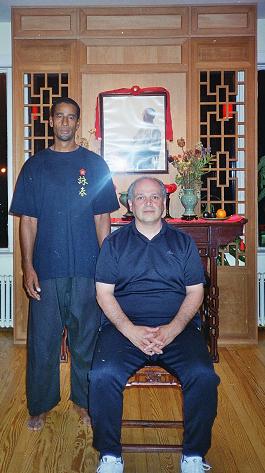Wing Chun Kung Fu in Barbados
Wing Chun in Barbados. — Wing Chun (Chinese: 詠春; pinyin: yǒng chūn; literally "spring chant"), also romanised as Ving Tsun or Wing Tsun, (and sometimes substituted with the characters 永春 "eternal springtime"); (also known as Snake-Crane style); is a concept-based Chinese martial art and form of self-defense utilizing both striking and grappling while specializing in close-range combat. The alternative characters 永春 "eternal spring" are also associated with some other southern Chinese martial arts, including Weng Chun Kungfu and White Crane Weng Chun (Yong Chun).
Barbados Wing Chun curriculum : Includes 3 forms empty hand forms ; 1 Wooden dummy form and 2 weapon forms.
BALANCE STRUCTURE STANCE Our Barbados Wing Chun curriculum teaches practically how a person with better body structure has an advantage. A correct Wing Chun stance is like a piece of bamboo, firm but flexible, rooted but yielding. This structure is used to either deflect external forces or redirect them. Balance is related to structure because a well-balanced body recovers more quickly from stalled attacks and structure is maintained. Wing Chun trains the awareness of one's own body movement derived from muscular, tendon, and articular sources. Performing Wing Chun's forms such as Chum Kiu or the Wooden Dummy form greatly improve proprioception. Wing Chun favors a high, narrow stance with the elbows kept close to the body. Within the stance, arms are positioned across the vitals of the centerline. Shifting or turning within a stance is carried out variantly on the heels, balls, or middle (K1 or Kidney 1 point) of the foot depending on lineage. All attacks and counter-attacks are initiated from this firm, stable base. Wing Chun rarely compromises structure for more powerful attacks because this is believed to create defensive openings which may be exploited. Structure is viewed as important, not only for reasons of defense, but also for attack. When the practitioner is effectively "rooted", or aligned so as to be braced against the ground, the force of the hit is believed to be far more devastating. Additionally, the practice of "settling" one's opponent to brace them more effectively against the ground aids in delivering as much force as possible to them.
RELAXATION Softness (via relaxation) and performing techniques in a relaxed manner, is fundamental to Wing Chun. Tension reduces punching speed and power. Muscles act in pairs in opposition to each other (e.g. biceps and triceps). If the arm is tensed, maximum punching speed cannot be achieved as the biceps will be opposing the extension of the arm. In Wing Chun, the arm should be relaxed before beginning the punching motion. Unnecessary muscle tension wastes energy and causes fatigue. Tense, stiff arms are less fluid and sensitive during trapping and chi sao. A tense, stiff limb provides an easy handle for an opponent to push or pull with, whereas a relaxed limb provides an opponent less to work with. A relaxed, but focused, limb affords the ability to feel "holes" or weaknesses in the opponent's structure (see Sensitivity section). With the correct forwarding these "holes" grant a path into attacking the opponent. Muscular struggle reduces a fight to who is stronger. Minimum brute strength in all movement becomes an equalizer in uneven strength confrontations. This is very much in the spirit of the tale of Ng Mui.
CENTERLINE While the existence of a "central axis" concept is unified in Wing Chun, the interpretation of the centerline concept itself is not. Many variations exist, with some lineages defining anywhere from a single "centerline" to multiple lines of interaction and definition. The most commonly seen interpretation emphasizes attack and defense along an imaginary horizontal line drawn from the center of the practitioner's chest to the center of the enemy's chest. The human body's prime striking targets are considered to be on or near this line, including eyes, nose, throat, solar plexus and groin. Wing Chun techniques are generally "closed", with the limbs drawn in to protect the central area and also to maintain balance. In most circumstances, the hands do not move beyond the vertical circle that is described by swinging the arms in front, with the hands crossed at the wrists. To reach outside this area, footwork is used. A large emphasis and time investment in training Chi Sao exercise emphasizes positioning to dominate this centerline. The stance and guard all point at or through the center to concentrate physical and mental intent of the entire body to the one target. Wing Chun practitioners attack within this central area to transmit force more effectively, since it targets the "core center" (or "mother line", another center defined in some lineages and referring to the vertical axis of the human body where the center of gravity lies). For example, striking an opponent's shoulder will twist the body, dispelling some of the force and weakening the strike, as well as compromising the striker's position. Striking closer to the center transmits more force directly into the body.
UNCOMMITTED TECHNIQUES Wing Chun techniques are uncommitted. This means that if the technique fails to connect, the practitioner's position or balance is less affected. If the attack fails, the practitioner is able to "flow" easily into a follow-up attack. All Wing Chun techniques permit this. Any punches or kicks can be strung together to form a "chain" of attacks. According to Wing Chun theory, these attacks, in contrast to one big attack, break down the opponent gradually causing internal damage. Chained vertical punches are a common Wing Chun identifier.
TRAPPING SKILLS AND SENSITIVITY The Wing Chun practitioner develops reflexes within the searching of unsecured defenses through use of sensitivity. Training through Chi Sao with a training partner, one practices the trapping of hands. When an opponent is "trapped", he or she becomes immobile. Chinese philosophy: "Greet what arrives, escort what leaves and rush upon loss of contact"- Yip Man
CLOSE RANGE Wing Chun teaches practitioners to advance quickly and strike at close range. While the Wing Chun forward kick can be considered a long range technique, many Wing Chun practitioners practice "entry techniques"—getting past an opponent's kicks and punches to bring him within range of Wing Chun's close range repertoire. This means that theoretically, if the correct techniques are applied, a shorter person with a shorter range can defeat a larger person by getting inside his range and attacking him close to his body.
CHI SAO Chi Sao (Chinese 黐手, Cantonese chi sau², Mandarin chǐshǒu) or "sticking hands". Term for the principle, and drills used for the development of automatic reflexes upon contact and the idea of "sticking" to the opponent. In Wing Chun this is practiced through two practitioners maintaining contact with each other's forearms while executing techniques, thereby training each other to sense changes in body mechanics, pressure, momentum and "feel". This increased sensitivity gained from this drill helps a practitioner attack and counter an opponent's movements precisely, quickly and with the appropriate technique. Chi Sao additionally refers to methods of rolling hands drills (Luk Sao). Luk Sao participants push and "roll" their forearms against each other in a single circle while trying to remain relaxed. The aim is to feel forces, test resistances and find defensive gaps. Other branches do a version of this where each of the arms roll in small separate circles. In some lineages (such as our Yip Man branches), Chi Sao drills begin with one-armed sets called Dan Chi Sao which help the novice student to get the feel of the exercise, each practitioner uses one hand from the same side as they face each other. Chi Sao is a sensitivity drill to obtain specific responses, it should not be confused with sparring/fighting, though it can be practiced or expressed in a combat form.
HISTORY OF WING CHUN Wing Chun was originally passed down from teacher to student orally rather than through written documentation, making it difficult to confirm or clarify the differing accounts of its creation. Mentions of the art start to appear in independent third-party documentation during the era of the Wing Chun master Leung Jan, making its subsequent history and divergence into various branches more amenable to documentary verification.
The common legend as told by Ip Man involves the young woman Yim Wing Chun (Wing Chun literally means forever springtime or praising spring) at the time after the destruction of the Southern Shaolin and its associated temples by the Qing government. After escaping the destruction of the Fujian Shaolin Monastery Shaolin Monastery (少林寺) by Qing forces, the Abbess Ng Mui one of the Five Elders (五祖) fled to the distant Daliang mountains (大涼山) on the border between Yunnan and Sichuan. One day, she came upon a fight between a snake and a crane (or other animal). She took the lessons she learned from observing the fight between the two animals and combined them with her own knowledge of Shaolin kung fu to create a new style.
Ng Mui often bought her bean curd at the tofu shop of Yim Yee (嚴二). Yim Yee had a daughter named Yim Wing-Chun (嚴詠春) Yan Yongchun (嚴詠春) whom a local Ching army tyrant was trying to force into marriage. After Wing Chun rebuffs the local warlord's marriage offer. The nun told the officer and told him that if he beat her in a fight she would marry him. He agreed to the fight. The Shaolin Nun Mg Mui, took the girl up to the nearest temple and taught her the newly developed fighting style. It was a totally different type of martial art, one that was meant for a young girl her size, a smarter way of fighting with short fast movement. When the fight came, the Ching army officer lost to the little girl named Wing Chun, he also lost face and left then left the area. Wing-Chun eventually married a man she loved, Leung Bok-Chao (梁博儔), to whom she taught the fighting techniques that Ng Mui had passed on to her. It was in Wing Chun’s honour that Ng Mui named her system of kung fu Ving Tsun which translates as beautiful springtime. Also the name of a hall in Shaolin Temple. This new system of kung fu was kept a well guarded secret. After many generations within the Wing Chun family, the Wing Chun Style of Kung Fu was past on from Dr. Lung Jun to his son Leung Bik and his top student Chan Wah Shun the money changer and then to Yip Man. In 1949, Yip Man brought the style out of Fatshan ( Foshan), China to Hong Kong and eventually, through his disciples, to the rest of the world. One of the most famous students coming out of his school was Bruce lee. Li Xiaolong (李小龍) He was the first person to teach Wing Chun to a wider public. After his death, many of his students formed separate schools.
NOTE: Wing Chun was developed during the Shaolin and Ming resistance movement against the Qing Dynasty, and thus many legends about the creator of Wing Chun were spread to confuse the enemy, including the story of Yim Wing Chun. Also, the story conveys the concept of using leverage and technique not physical brute strength to subdue an opponent.
VARIOUS BRANCHES OF WING CHUN INCLUDE:
1. IP MAN BRANCH ( Ip Man Wing Chun Curriculum) 2. Yiu Kai branch 3. Jiu Wan branch 4. Gulao (Koo Lo) Village branch 5. Pan Nam branch 6. Yuen Kay-San branch 7. Nguyễn Tế-Công branch (Vietnam Wing Chun 永春) 8. Cho family branch 9. Hung Fa Yi/Hung Suen Wing Chun Kuen 10. Pao Fa Lien branch 11. Fut Sao (Buddha Hand) branch 12. Weng Chun ( Shaolin Temple) |



|
Sifu Reginald Cooper |
|
Sifu Jason Lau |

|
Ving Tsun Kung Fu
Sifu Sealy & Sifu Miguel Hernandez |




|
Great Grand Master Ip Man & Moy Yat G. Master Moy Yat & Miguel Hernandez |


|
Sifu Miguel Hernandez & Sifu Ricardo Sealy |
|
Wing Chun Instructor (Barbados,) Sifu Ricardo Sealy at Shaolin Temple central China |


|
Sifu Cecil Siao-Pao |

|
Sifu Michael Militano |